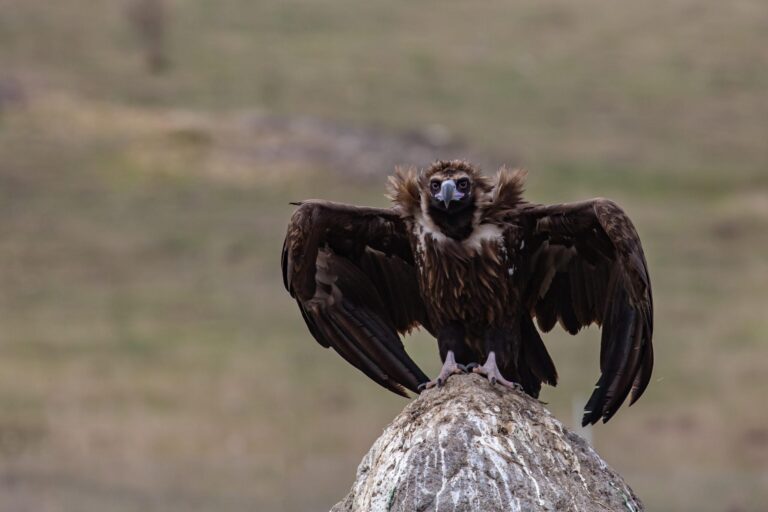Cinereous vultures are making a remarkable comeback in parts of Europe, with recent sightings soaring over Spain and Bulgaria. These impressive birds, once on the brink of local extinction, are now benefiting from concerted conservation efforts driven by Rewilding Europe. The revival of cinereous vulture populations not only marks a significant milestone in biodiversity restoration but also highlights the growing success of rewilding initiatives across the continent.
Cinereous Vultures Soar Again Across Spain and Bulgaria Marking a Milestone in Rewilding Efforts
After decades of decline due to habitat loss and poisoning, the majestic cinereous vulture is reclaiming the skies over select regions in Spain and Bulgaria. Conservationists, local communities, and rewilding initiatives have collaborated to create safe havens and corridors, facilitating the species’ comeback. These efforts include strict anti-poisoning regulations, supplemental feeding programs, and the restoration of natural forests. The result is a vibrant display of these giant birds soaring once again, signaling a vital ecological recovery and the positive impact of coordinated wildlife management.
Key factors contributing to this encouraging resurgence include:
- Protected nesting sites: Secure areas shielded from human disturbance.
- Community engagement: Local populations educated and involved in vulture conservation.
- Monitoring programs: Continuous tracking of population dynamics and health.
| Region | Current Estimated Population | Major Conservation Activity |
|---|---|---|
| Spain (Sierra de la Demanda) | 150 pairs | Supplemental feeding stations |
| Bulgaria (Central Balkan National Park) | 80 pairs | Anti-poisoning patrols |
The resurgence is not only a win for the species but also for the broader ecosystem, as cinereous vultures play a crucial role in nutrient recycling and disease control. Their soaring presence underscores the success of rewilding practices and renews hope for the restoration of other endangered species reliant on similar habitats.
Habitat Restoration and Community Engagement Drive Success of Vulture Populations in Europe
Efforts to restore natural habitats across key regions in Spain and Bulgaria have been pivotal in reviving the once-declining populations of cinereous vultures. These majestic birds, known for their impressive wingspan, have found new safe havens as rewilding initiatives focus on preserving and enhancing the extensive forests and open landscapes they favor. Restoration projects have included removing invasive vegetation, planting native tree species, and securing reliable food sources to support healthy breeding colonies. Together, these measures have helped create a sustainable environment where vultures can nest, forage, and thrive away from the threats of habitat fragmentation and human disturbance.
Community engagement has played an equally crucial role in this conservation success story. Local stakeholders, including farmers, hunters, and volunteers, have actively participated in awareness campaigns and monitoring programs, fostering a shared commitment to protecting these scavengers. Educational workshops and citizen science initiatives have empowered residents to contribute directly to data collection and habitat protection efforts. Key strategies driving this collaborative approach include:
- Regular vulture population surveys coordinated by trained local volunteers
- Establishment of vulture feeding sites to supplement natural food availability
- Workshops promoting coexistence between livestock farmers and scavengers
- Partnerships with regional authorities to enforce anti-poisoning regulations
| Region | Population Growth (2015-2023) | Key Conservation Actions |
|---|---|---|
| Spain (Sierra de la Demanda) | +45% | Habitat restoration & feeding stations |
| Bulgaria (Rila Mountains) | +38% | Community-based monitoring & anti-poisoning patrols |
Recommendations for Sustained Conservation and Cross-Border Collaboration to Secure Future Growth
Ensuring the long-term survival of the cinereous vultures hinges on continued conservation efforts that extend beyond national boundaries. Coordinated initiatives between Spain and Bulgaria, incorporating local communities and stakeholders, are vital to maintain and expand safe habitats. Focused actions include the restoration of feeding sites, stringent anti-poisoning enforcement, and rigorous monitoring of population dynamics. Moreover, public education campaigns must emphasize the crucial ecological role these scavengers play in sustaining healthy ecosystems.
Cross-border collaboration is further strengthened through shared scientific research and data exchange, fostering a unified approach to tackling common challenges. Key priorities involve:
- Joint tracking programs to map migratory patterns
- Standardized protocols for nest protection
- Exchange of best practices on habitat management
These efforts create a resilient network that supports the vultures’ natural range expansion and genetic diversity, laying a solid foundation for thriving populations across Europe.
| Conservation Action | Spain | Bulgaria |
|---|---|---|
| Feeding Site Restoration | 15 sites refurbished | 10 sites refurbished |
| Anti-poisoning Patrols | Weekly patrols | Biweekly patrols |
| Community Workshops | 12 held annually | 8 held annually |
| Satellite Tracking Tags | 30 deployed | 25 deployed |
To Wrap It Up
As Cinereous vultures once again take to the skies over Spain and Bulgaria, their resurgence stands as a testament to the power of dedicated conservation and rewilding efforts. These majestic birds not only symbolize the revival of Europe’s natural heritage but also play a crucial role in maintaining healthy ecosystems. With continued support and collaboration, rewilding initiatives like these offer hope for sustaining biodiversity and restoring balance to Europe’s wild landscapes for generations to come.




